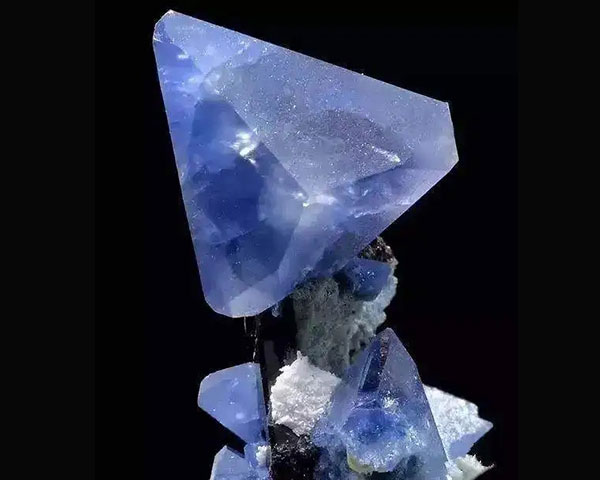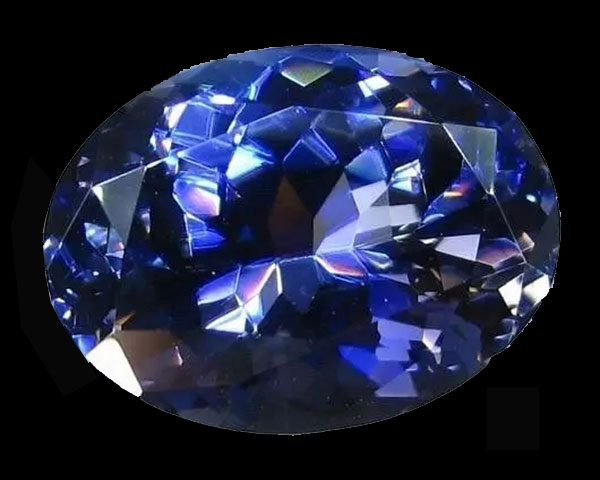The name Benitoite comes from the mineral discovery place, San Benito River, San Binhuang County, California, United States, which was discovered and named in 1906.
Benitoite is a gem mineral with a color similar to sapphire. Its particles are tiny, and few are more than 2ct,
It is only a Benitoite gem in the Smithsonian Museum in Washington, USA, and weighs 7.8ct, and a Benitoite in the Natural History Museum in New York, USA, weighs 3.57ct.

Basic properties of Benitoite
- Chemical formula: BaTiSi3O9
- Form: Benitoite belongs to the hexagonal crystal system. The better crystal form is a plate or column crystal with triangular cross-section.
- Mohs hardness: 6~7.
- Cleavage: A group of incomplete cleavages.
- Density: 3.65~3.68g/cm.
- Optical property: inhomogeneous body, uniaxial crystal, positive optical property.
- Refractive index: 1.757~1.804, birefringence: 0.047.
- Dispersion: 0.046.
- Gloss: glass luster.
- Color: primarily blue, but also purple, pink, colorless, etc.
- Polychromism: Colored crystals are moderate to strongly polychromatic.
- Transparency: Transparent.
Physical characteristics of Benitoite
- With Glass luster to sub-adamantine luster, transparent to translucent,
- Blue to violet-blue, often with light blue, colorless or white bands, rarely pink.
- Positive optical property of uniaxial crystal, refractive index: No=1.757, Ne=1.804,
- Birefringence: 0.047,
- Dispersion degree: 0.044.
- Strong Polychromism: blue is dark blue and almost colorless, while purple is purplish red and purple.
- Benitoite is sentimental under long-wave ultraviolet fluorescence and strong blue-white fluorescence under short-wave light.
- One group of incomplete cleavage,
- The fracture is shell to stagger,
- The Mohs hardness is 6-6.5,
- The density is 3.68 (+0.01, -0.07) g/cm.
Occurrence and origin
The Benitoite mineral is in the metamorphic serpentinite and is associated with white sodium zeolite and pillstone. The origin of Benitoite is California, USA. This is almost the only place where gem-grade Benitoite is produced.
How to Identify Benitoite
- Color: blue, blue-purple.
- Refractive index: 1.75~1.80 (high).
- Birefringence index: 0.047 (high), noticeable double shadow lines of faceted edges when viewed at magnification.
- Luminescence characteristics: Blue Benitoite emits bright blue fluorescence under short-wave ultraviolet light. It can be used as one of the diagnostic criteria.
- Polychromism: strong
- Fire color: As the dispersion value is up to 0.046, “fire color” can appear in the finished Benitoite.

The difference between Benitoite and similar gemstones
Benitoite is similar to sapphire but has higher birefringence, positive light, strong Polychromism, and optical dispersion that the naked eye can observe.
It is similar to blue spinel and blue Glass, but the latter two are homogeneous, which can be distinguished by the polarizing mirror and dichroic mirror.
Magnified observation shows visible ribbons, heavy shadow, and strong dispersion. In some cases, zeolite and gas-liquid inclusion can also be seen.
Benitoite is similar to sapphire. There are five differences between them by the naked eye:
Benitoite has strong luster and high dispersion, and fire colors can be seen in the polished Benitoite interface;
Obvious dichroism: it is bright blue when viewed in the direction perpendicular to the table facet of Benitoite, and colorless or very light blue when viewed in the direction parallel to the table facet.
This property is somewhat similar to that of Cordierite, but Cordierite has tricolor, no fire color, its luster is weaker than that of Benitoite, and its surface is not as bright as that of Benitoite;
The hardness of Benitoite (6-6.5) is obviously lower than that of sapphire, and it can draw marks with steel frustrations;
The birefringence of Benitoite is large (0.04), and the prism double shadow can be clearly seen on the bottom edge;
The particle size is small, and the Benitoite larger than 1 carat is not easy to see.
Conclusion:
Benitoite mineral is produced in the white natrolite granular aggregate or block of the altered serpentine, and is associated with black columnar Astrophyllite and white natrolite. The largest crystal diameter of the Benitoite mineral is 5cm, mainly white and blue, and few pink and colorless transparent minerals.
Benitoite crystals are usually small and flawed, and it is extremely rare to reach gem level.
The 0.2-carat weight Benitoite has been used as a gem. Because its dispersion reaches 0.046, which is equivalent to the dispersion of diamonds, colorless transparent Benitoite can appear in fire colors similar to diamonds after grinding and can be used as substituties for diamonds.
